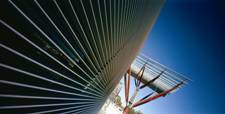
A tool that helps find people trapped in buildings via mobile phone signals and easy-to-use luggage for wheelchair users are just two products on show at the Industrial Design Graduand Exhibition at UNSW.
Final-year student David George went to Christchurch in the wake of the earthquake and was struck how even highly advanced societies are “brought back to the Stone Age with only slow and primitive techniques” when a natural disaster strikes.
“A couple of times a day they would stop planes and helicopters from flying over the city, so they could hear any noise from the debris,” George says.
As a result of his research, he developed the EMTracker, which counts the number of people found in scanned areas, allowing rescue teams to prioritise search plans.
The information is streamed into a rescuer’s smartphone presenting it in a 3D map.
Joseph Louis Tan, 24, was inspired to design luggage for wheelchair users, after helping his parents, both of whom use wheelchairs, with their travel requirements.
“They always need help from other people with their luggage,” says Tan.
His prototype allows for independent travel, as users can attach the case to the back of the chair by reversing into it. There is also a luggage strap to secure it to the user’s waist.
Another product which is on display is ExpressLove, aimed at breastfeeding mothers who have returned to work.
Lyvia Alam’s thermos-like device maintains expressed milk at fridge temperature, but is also able to heat it to 37 degrees, the temperature required for feeding.
“This device reassures mothers that their milk has not gone off, plus it is more convenient than having to reheat it in a saucepan of water on a stove top,” she says.
All the products in the exhibition are in the Industrial Design catalogue.pdf
